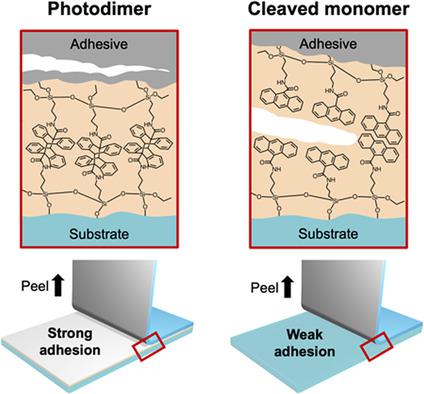当前位置:
X-MOL 学术
›
Adv. Eng. Mater.
›
论文详情
Our official English website, www.x-mol.net, welcomes your
feedback! (Note: you will need to create a separate account there.)
Dismantlable Adhesion Interface Featuring a Thermo/Photocleavable Molecular Layer
Advanced Engineering Materials ( IF 3.4 ) Pub Date : 2021-09-03 , DOI: 10.1002/adem.202100823 Miho Aizawa 1 , Harushisa Akiyama 2 , Yoko Matsuzawa 1
Advanced Engineering Materials ( IF 3.4 ) Pub Date : 2021-09-03 , DOI: 10.1002/adem.202100823 Miho Aizawa 1 , Harushisa Akiyama 2 , Yoko Matsuzawa 1
Affiliation

|
Dismantlable adhesion systems are becoming increasingly important in industrial applications, as they facilitate the recycling of a range of materials. Many dismantlable adhesives have been developed in response to this demand; however, their dismantling mechanisms are limited to those that utilize changes in bulk state. Herein, a novel dismantling adhesion system that enables the adhesion strength to be reduced based on covalent bond change is proposed. This is achieved by using a thermo- and photocleavable molecular layer comprising an anthracene photodimer. The molecular layer applied at the adhesion interface exhibits an adhesion strength twice that of the uncoated substrate, based on the formation of covalent bonds between the substrates and adhesives. Heating the adhered specimen for 1 min successfully reduces the peel strength by 60% and induces dismantling at the molecular layer. Furthermore, it is possible to dismantle adhesive joint through a low-energy photocleavage process with light irradiation. This process requires under 10% of the energy of other light-triggered dismantlable adhesives. The proposed system provides new insights for the development of dismantlable adhesion technology, leveraging the adhesion mechanism at the interface.
中文翻译:

具有热/光裂解分子层的可拆卸粘附界面
可拆卸粘合系统在工业应用中变得越来越重要,因为它们有助于回收一系列材料。针对这种需求,开发了许多可拆胶粘剂;然而,它们的拆除机制仅限于那些利用散装状态变化的机制。在此,提出了一种基于共价键变化能够降低粘合强度的新型拆卸粘合系统。这是通过使用包含蒽光二聚体的可热裂解和可光裂解的分子层来实现的。基于基材和粘合剂之间共价键的形成,在粘合界面上施加的分子层的粘合强度是未涂层基材的两倍。将粘附的样品加热 1 分钟成功地降低了 60% 的剥离强度,并在分子层引起了分解。此外,可以通过光照射的低能光裂解过程拆除粘合接头。这个过程需要的能量不到其他光触发可拆卸粘合剂的 10%。所提出的系统利用界面处的粘附机制为可拆卸粘附技术的发展提供了新的见解。
更新日期:2021-09-03
中文翻译:

具有热/光裂解分子层的可拆卸粘附界面
可拆卸粘合系统在工业应用中变得越来越重要,因为它们有助于回收一系列材料。针对这种需求,开发了许多可拆胶粘剂;然而,它们的拆除机制仅限于那些利用散装状态变化的机制。在此,提出了一种基于共价键变化能够降低粘合强度的新型拆卸粘合系统。这是通过使用包含蒽光二聚体的可热裂解和可光裂解的分子层来实现的。基于基材和粘合剂之间共价键的形成,在粘合界面上施加的分子层的粘合强度是未涂层基材的两倍。将粘附的样品加热 1 分钟成功地降低了 60% 的剥离强度,并在分子层引起了分解。此外,可以通过光照射的低能光裂解过程拆除粘合接头。这个过程需要的能量不到其他光触发可拆卸粘合剂的 10%。所提出的系统利用界面处的粘附机制为可拆卸粘附技术的发展提供了新的见解。











































 京公网安备 11010802027423号
京公网安备 11010802027423号